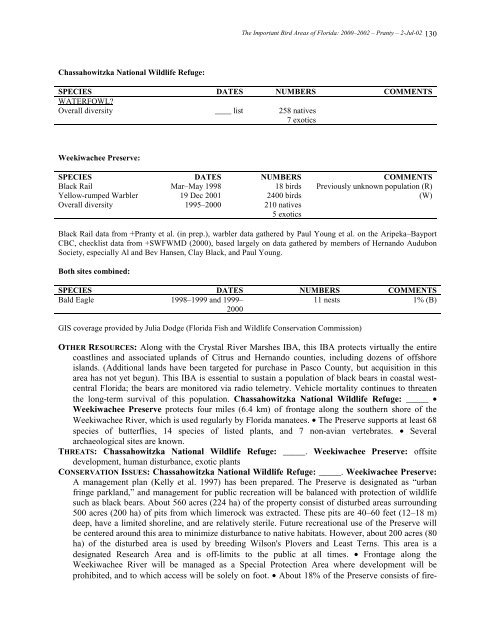The Important Bird Areas of Florida - National Audubon Society
The Important Bird Areas of Florida - National Audubon Society
The Important Bird Areas of Florida - National Audubon Society
Create successful ePaper yourself
Turn your PDF publications into a flip-book with our unique Google optimized e-Paper software.
<strong>The</strong> <strong>Important</strong> <strong>Bird</strong> <strong>Areas</strong> <strong>of</strong> <strong>Florida</strong>: 2000–2002 – Pranty – 2-Jul-02 130Chassahowitzka <strong>National</strong> Wildlife Refuge:SPECIES DATES NUMBERS COMMENTSWATERFOWL?Overall diversity ____ list 258 natives7 exoticsWeekiwachee Preserve:SPECIES DATES NUMBERS COMMENTSBlack Rail Mar–May 1998 18 birds Previously unknown population (R)Yellow-rumped Warbler 19 Dec 2001 2400 birds (W)Overall diversity 1995–2000 210 natives5 exoticsBlack Rail data from +Pranty et al. (in prep.), warbler data gathered by Paul Young et al. on the Aripeka–BayportCBC, checklist data from +SWFWMD (2000), based largely on data gathered by members <strong>of</strong> Hernando <strong>Audubon</strong><strong>Society</strong>, especially Al and Bev Hansen, Clay Black, and Paul Young.Both sites combined:SPECIES DATES NUMBERS COMMENTSBald Eagle 1998–1999 and 1999–11 nests 1% (B)2000GIS coverage provided by Julia Dodge (<strong>Florida</strong> Fish and Wildlife Conservation Commission)OTHER RESOURCES: Along with the Crystal River Marshes IBA, this IBA protects virtually the entirecoastlines and associated uplands <strong>of</strong> Citrus and Hernando counties, including dozens <strong>of</strong> <strong>of</strong>fshoreislands. (Additional lands have been targeted for purchase in Pasco County, but acquisition in thisarea has not yet begun). This IBA is essential to sustain a population <strong>of</strong> black bears in coastal westcentral<strong>Florida</strong>; the bears are monitored via radio telemetry. Vehicle mortality continues to threatenthe long-term survival <strong>of</strong> this population. Chassahowitzka <strong>National</strong> Wildlife Refuge: _____ •Weekiwachee Preserve protects four miles (6.4 km) <strong>of</strong> frontage along the southern shore <strong>of</strong> theWeekiwachee River, which is used regularly by <strong>Florida</strong> manatees. • <strong>The</strong> Preserve supports at least 68species <strong>of</strong> butterflies, 14 species <strong>of</strong> listed plants, and 7 non-avian vertebrates. • Severalarchaeological sites are known.THREATS: Chassahowitzka <strong>National</strong> Wildlife Refuge: _____. Weekiwachee Preserve: <strong>of</strong>fsitedevelopment, human disturbance, exotic plantsCONSERVATION ISSUES: Chassahowitzka <strong>National</strong> Wildlife Refuge: _____. Weekiwachee Preserve:A management plan (Kelly et al. 1997) has been prepared. <strong>The</strong> Preserve is designated as “urbanfringe parkland,” and management for public recreation will be balanced with protection <strong>of</strong> wildlifesuch as black bears. About 560 acres (224 ha) <strong>of</strong> the property consist <strong>of</strong> disturbed areas surrounding500 acres (200 ha) <strong>of</strong> pits from which limerock was extracted. <strong>The</strong>se pits are 40–60 feet (12–18 m)deep, have a limited shoreline, and are relatively sterile. Future recreational use <strong>of</strong> the Preserve willbe centered around this area to minimize disturbance to native habitats. However, about 200 acres (80ha) <strong>of</strong> the disturbed area is used by breeding Wilson's Plovers and Least Terns. This area is adesignated Research Area and is <strong>of</strong>f-limits to the public at all times. • Frontage along theWeekiwachee River will be managed as a Special Protection Area where development will beprohibited, and to which access will be solely on foot. • About 18% <strong>of</strong> the Preserve consists <strong>of</strong> fire-
















